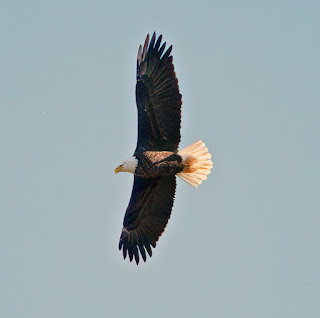NATURE MONCTON NATURE INFORMATION LINE, Nov 12, 2021 (Friday)
To respond by e-mail, please address your message to the information line editor, nelsonpoirier435@gmail.com .
Please advise the editor at nelsonpoirier435@gmail.com if any errors are noted in wording or photo labelling.
For more information on Nature Moncton, check the website at www.naturemoncton.com .
Edited by: Nelson Poirier nelsonpoirier435@gmail.com
**A Common Raven chased a young Rock Pigeon until the prey hit a piece of pipe along the Riverfront Trail boardwalk, got knocked out and was taken apart by the predator. Lots of people saw this and could not believe that this activity took place so close to people. They were at the landing waiting for the Bore and never expected this.
Georges photo shows the raptor-like abilities of the Common Raven. Note the huge powerful bill when this species is seen up close.
**Strangler flocks of blackbirds continue. Jane LeBlanc had a flock of 15-20 Red-winged Blackbirds arrive to her St. Martins feeder yard of Thursday spending most of the day coming and going. Jane photographed an immature male.
**It’s that time of year after leaf fall we start to see nests that were well camouflaged among the leaves. Lynda LeClerc came across a nest beside the Humphrey Brook Trail approximately 3-4 feet off the ground and an approximate 6-inch bowl. It appears like it may have been a Cedar Waxwing nest. The extensive use of Old Man’s Beard lichen in Cedar Waxwing nest construction is a clue. Any other suggestions would be appreciated.
**A query has arisen about Northern Cardinals foraging on berries.
An Internet search provided an interesting commentary below:
“Although seeds are a favorite food, Northern cardinals also eat a lot of berries. As nonmigratory birds, they seek a variety of foods as availability changes throughout the year. “They’re pretty adaptive,” Gary says. “They have to be, as a resident bird.” But as they consume fruits, studies suggest, cardinals still are after the seeds, often discarding much of the fruit pulp. For that reason, fruits with larger seeds may be more attractive. Look for berry bushes with a range of fruiting times and, since cardinals forage low to the ground, dwarf shrubs. To attract cardinals, try sumac, dogwood, hackberry, northern bayberry and serviceberry. Here’s how to attract backyard birds with berries.”
**It’s Friday and time to review what next week’s sky may show courtesy of Curt Mason. Maybe some of us didn’t care for the time change last weekend but it does make for more evening sky gazing.
This Week’s Sky at a Glance, 2021 November 13 – November 20
At the mercy of the weather, night-owl stargazers or very early risers could be treated to a deep partial lunar eclipse on Friday morning. This is our first lunar eclipse since January 2019, as we missed one that started at moonset in May.
Although the full Moon starts slipping into Earth’s dark shadow, called the umbra, at 3:18 am, look for subtle gray shading on the lunar surface beginning a half hour sooner. This is the penumbra, a lesser shadow created when Earth partly covers the Sun as seen from the Moon. From 3:18 the umbra will creep across the lunar surface, reaching maximum eclipse at 5:03 with 97% of the Moon in shadow and creating a diamond ring effect. Note that the umbra appears on the left side, which indicates the Moon is moving eastward in its orbit rather than the westward motion we see as our planet rotates. Also, note the curvature of the shadow. Aristotle noticed this in the fourth century BC and correctly assumed it was because the Earth is spherical.
The Pleiades star cluster, also called the Seven Sisters and M45, will be just above the Moon. Use binoculars to watch for more stars to appear in the cluster as the sky darkens toward maximum eclipse. The partial phase lasts for three and a half hours, ending at 6:47 am. The Moon could take on a red or orange hue during mid-eclipse, caused by our atmosphere acting like a lens and bending the red part of the sunlight toward the Moon. Moonset occurs before the end of the penumbral phase but it would be too difficult to see it then anyway. The next lunar eclipse, a total one, will occur on May 15/16 next year.
This Week in the Solar System
Saturday’s sunrise in Moncton is at 7:17 am and sunset will occur at 4:49 pm, giving 9 hours, 32 minutes of daylight (7:20 am and 4:56 pm in Saint John). Next Saturday the Sun will rise at 7:27 am and set at 4:42 pm, giving 9 hours, 15 minutes of daylight (7:29 am and 4:49 pm in Saint John).
The full Moon passes almost completely within Earth’s shadow on Friday morning, a deep partial eclipse.
With the time change Saturn now sets around 10:10 pm this weekend, followed by Jupiter at 11:30. Venus is a few weeks away from being at its brightest and commands attention in the southwest as evening twilight fades. Mars can be seen, with luck, rising an hour before sunrise while Mercury is plunging sunward. The Leonid meteor shower peaks on November 17/18 but don’t expect much for fireworks. A few times over the past two centuries this shower has produced meteors at a rate of greater than ten per second.
On Sunday evening at 8 pm, tune in to the Sunday Night Astronomy Show via the Facebook page or YouTube channel of Astronomy by the Bay.
Questions? Contact Curt Nason at nasonc@nbnet.nb.ca.
nelsonpoirier435@gmail.com
Nelson Poirier
Nature Moncton











